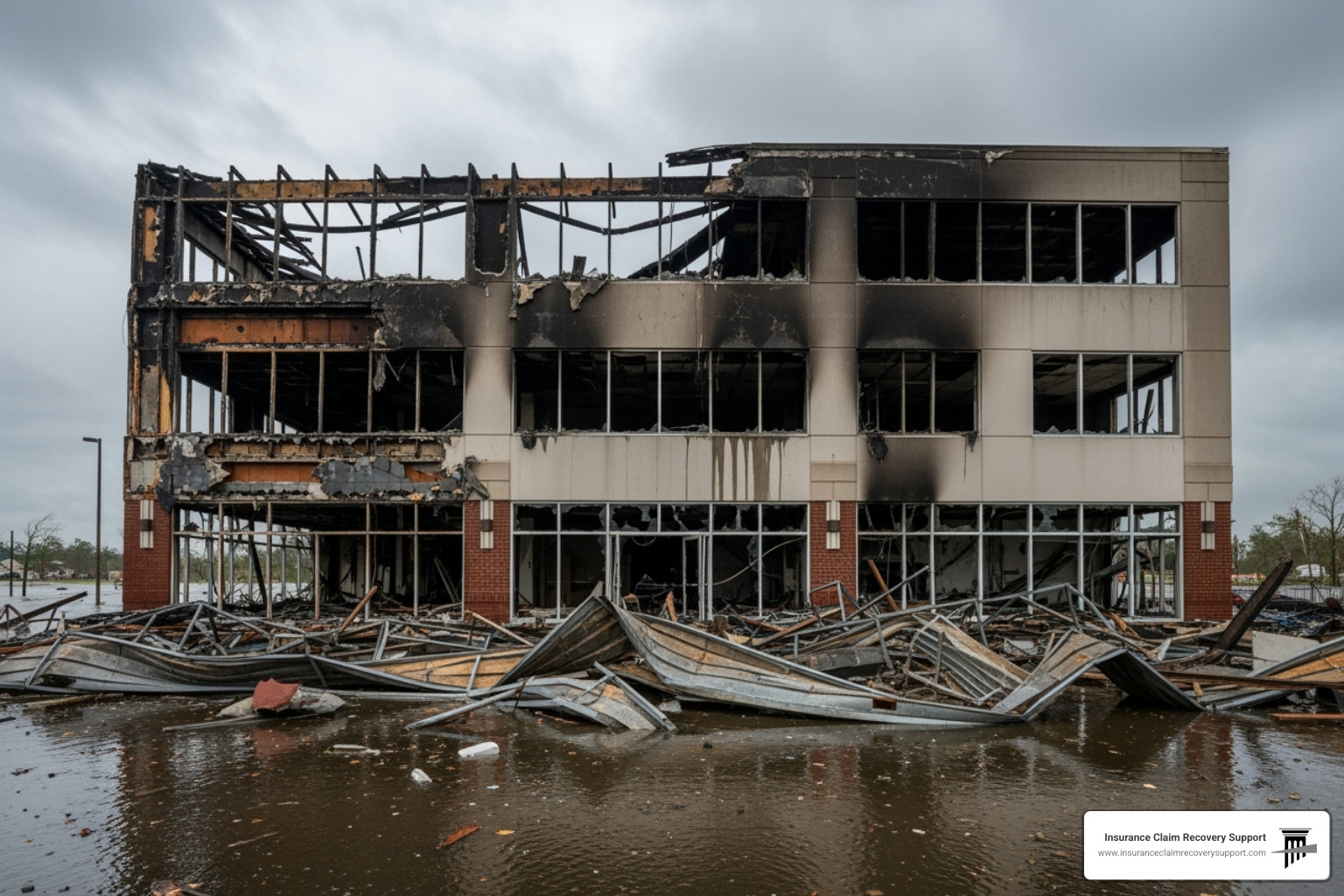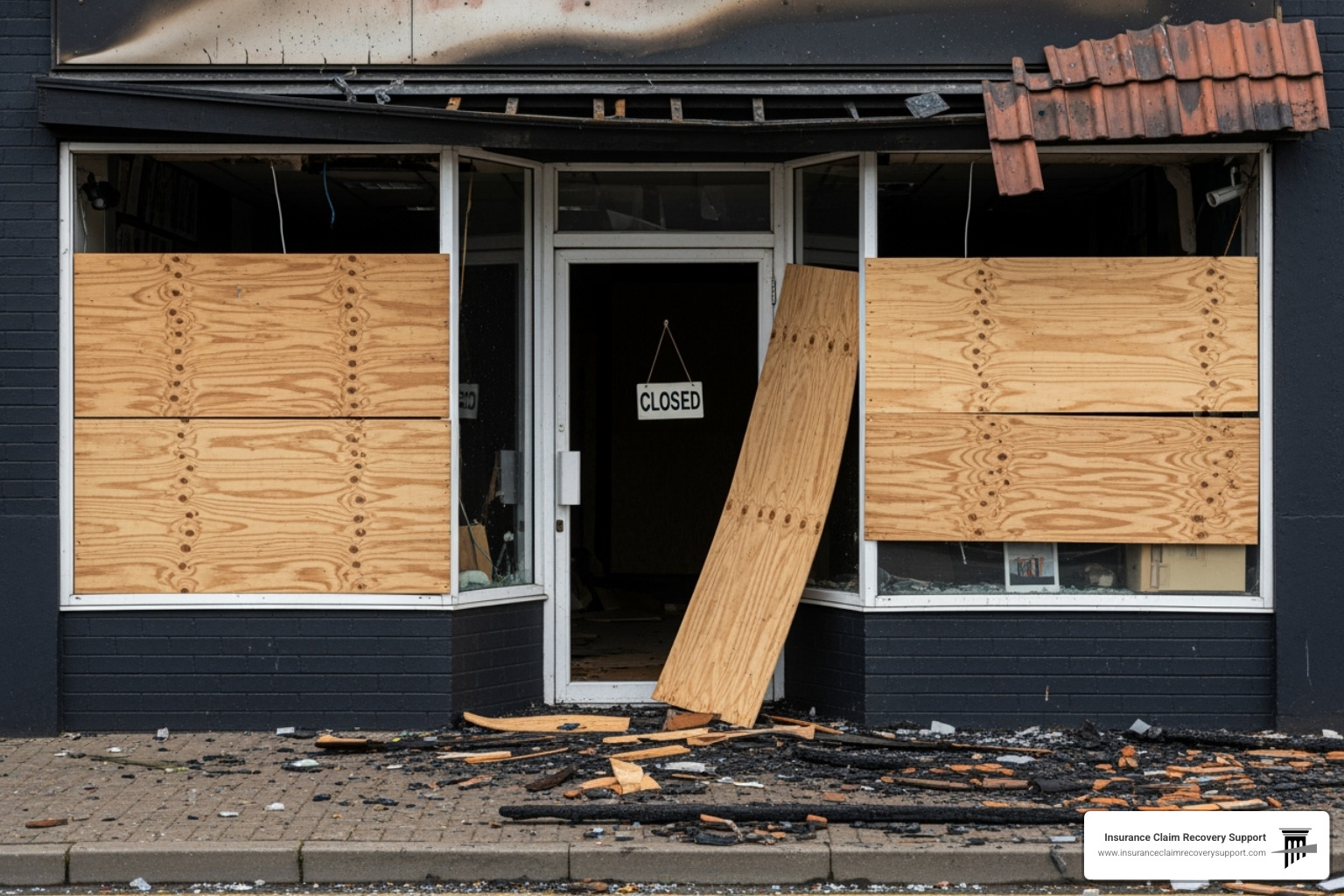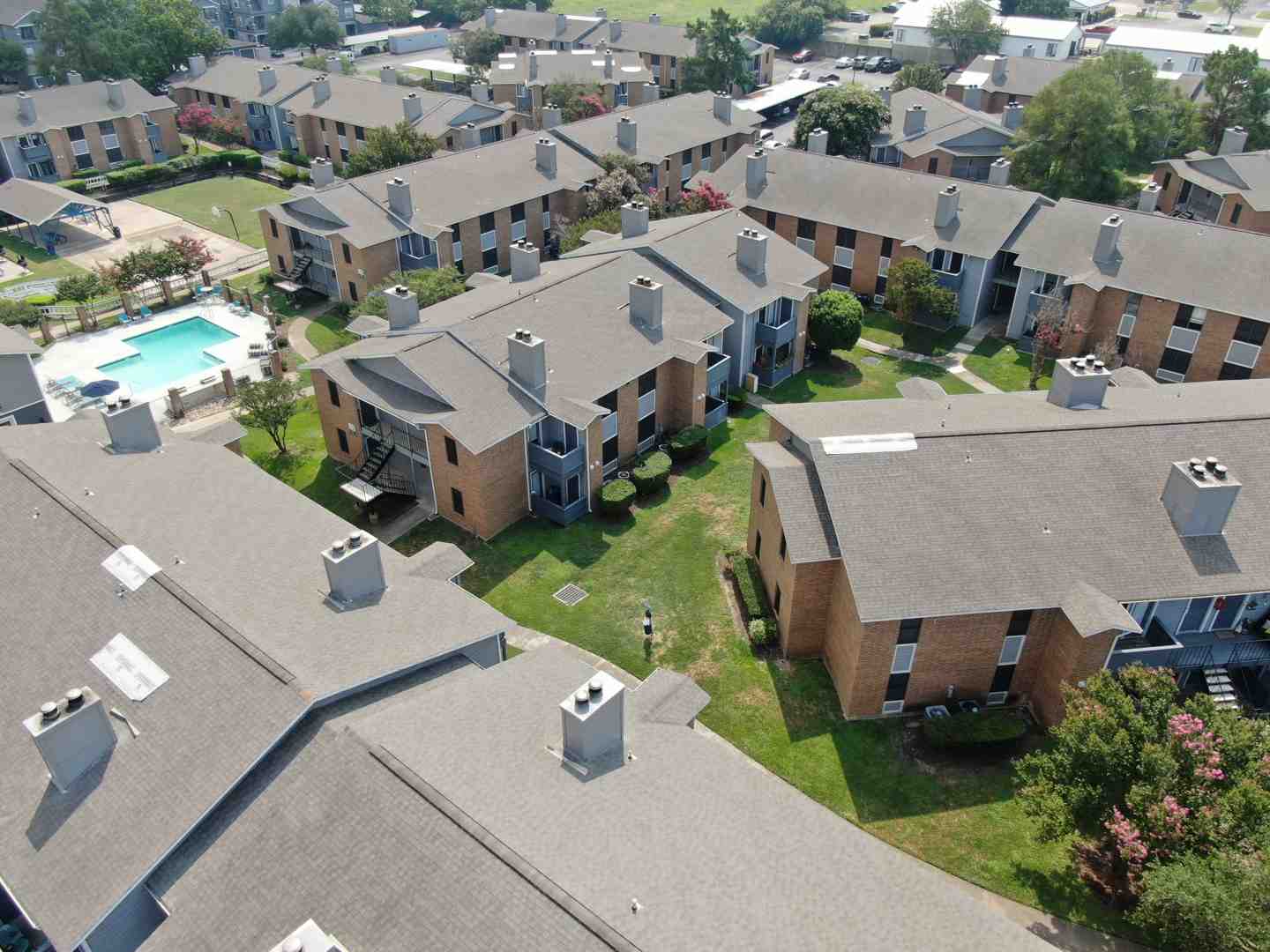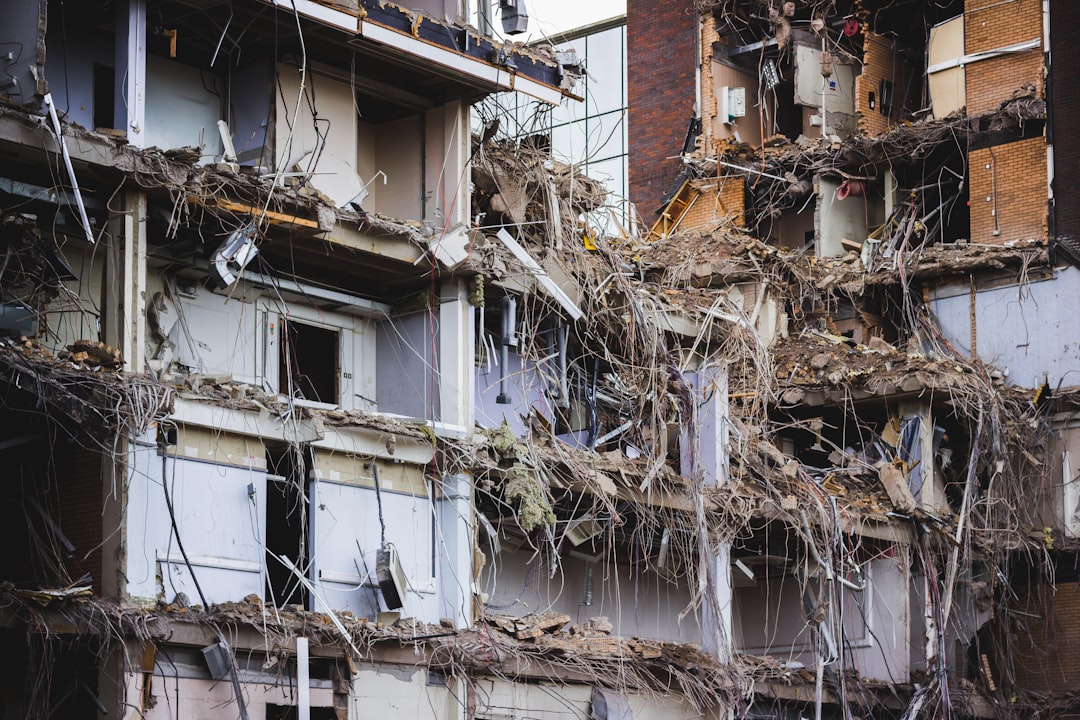Why Understanding Your Commercial Property Loss Claim Rights Matters
A commercial property loss claim can be overwhelming. Whether you’re facing damage from a fire, burst pipes, or a storm, knowing how to steer the claims process is the difference between a full recovery and a devastating financial loss.
Quick Answer: What is a commercial property loss claim?
- Definition: A formal request to an insurer for compensation after your commercial property suffers covered damage.
- Common triggers: Fire, hail, hurricane, tornado, lightning, freeze, wind, theft, vandalism.
- Key components: Property damage, business interruption, extra expenses.
- Timeline: Must be reported promptly, often within 24-72 hours.
- Documentation needed: Photos, repair estimates, financial records, Proof of Loss forms.
The stakes are high. According to FEMA, almost 40 percent of small businesses never reopen following a disaster. This statistic highlights why getting your claim handled correctly is about business survival.
Too often, policyholders steer this complex process alone, unaware that insurers have teams of adjusters and specialists working to minimize payouts. This guide will help you understand your rights and the true value of your claim.
I’m Scott Friedson, a public adjuster who has settled over $250 million in large loss claims. My experience overturning wrongfully denied claims and increasing settlements by 30% to 3,800% shows how proper claim handling can transform a business’s recovery.
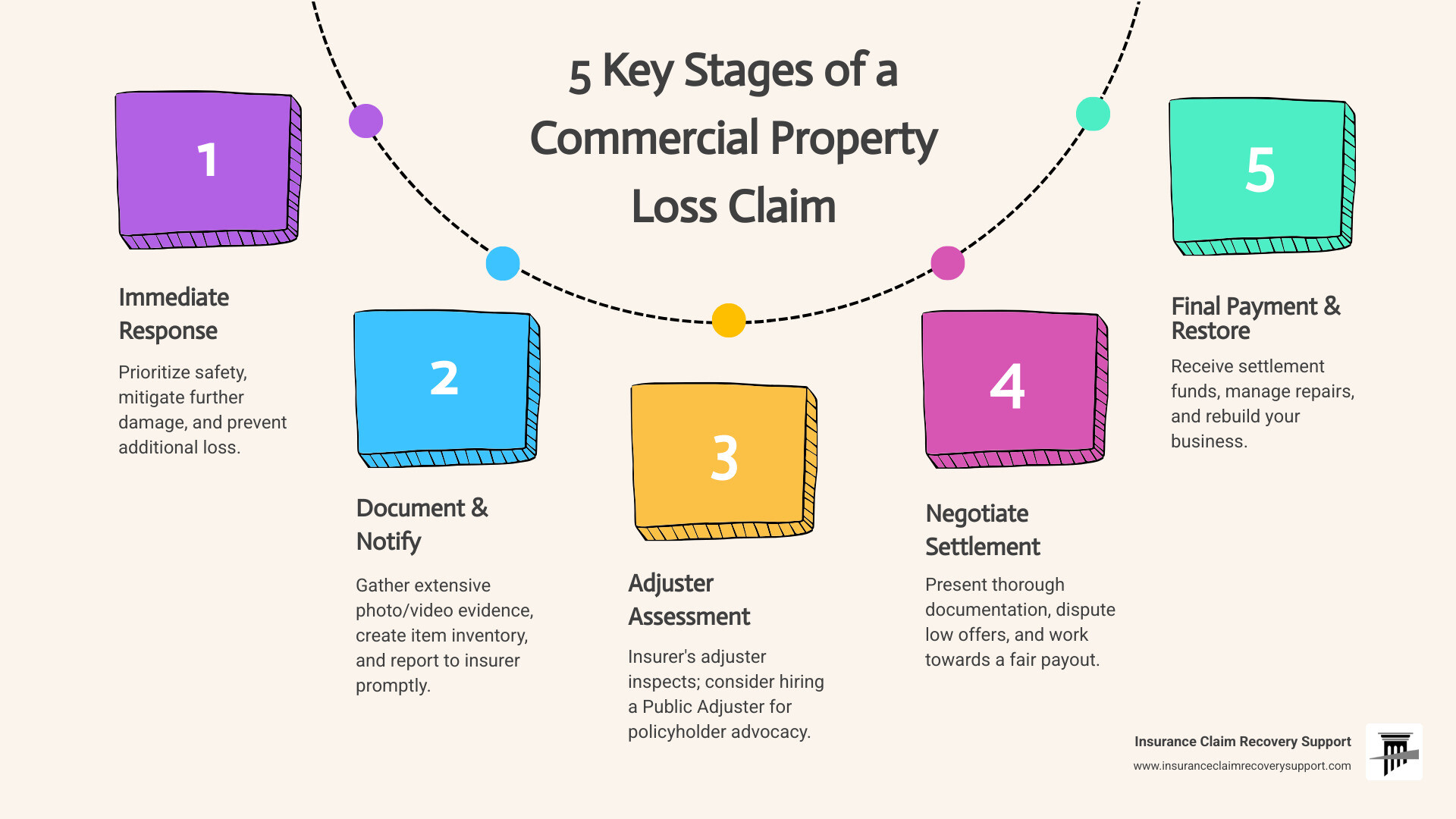
Understanding Your Commercial Property Insurance: Coverage, Exclusions, and Deductibles
Think of your commercial property insurance as your business’s safety net. Understanding how it works before you need it is critical. Many business owners only find gaps in coverage after filing a commercial property loss claim.
What’s Covered? Typical Inclusions in a Standard Policy
Building coverage protects the physical structure—walls, roof, and foundation. If a tornado in Austin tears off your roof, this is the coverage that applies.
Business Personal Property (BPP) covers the contents that make your business run: your equipment, computers, furniture, and inventory.
Typical covered perils include fire damage, lightning, wind damage, vandalism, and theft. If someone breaks into your Houston warehouse or lightning strikes your Dallas office, you’re generally covered.
Business Interruption coverage is vital. It replaces lost income and covers ongoing expenses like rent and payroll when a covered event forces a temporary shutdown. This coverage can be the difference between survival and closure.
You can find more info about Commercial Property Claims on our website for additional details.
What’s NOT Covered? Common Exclusions and Necessary Endorsements
Insurance policies have exclusions. Understanding these gaps is as important as knowing your coverage, as they often require separate policies.
Common exclusions include flood damage and earthquake damage. You need separate policies for these perils. Standard policies also exclude damage from inadequate maintenance, intentional damage, and normal wear and tear. Insurers expect you to be a responsible property owner.
For Texas businesses, especially on the coast, wind and hail may be excluded from standard policies. A separate windstorm endorsement is often necessary. These exclusions are spelled out in your policy; read them carefully and purchase additional coverage where needed. We also cover specific situations like cosmetic exclusion in insurance that can affect damage evaluation.
Decoding Your Deductible: How It Affects Your Final Payout
Understanding your deductible type prevents surprises during a claim.
A flat deductible is a fixed amount (e.g., $5,000) you pay before the insurer covers the rest.
Percentage deductibles, common for catastrophic events like hurricanes, are based on your total insured property value, not the loss amount. A 2% deductible on a $1 million property is $20,000, whether the damage is $25,000 or $250,000.
A time element deductible is a waiting period (e.g., 72 hours) before business interruption coverage starts. If you’re shut down for five days with a 72-hour waiting period, you’re only covered for the last two days.
The payout calculation subtracts your deductible from the covered loss. Understanding this helps you plan for the financial impact of a catastrophic loss. For comprehensive disaster planning, check out this business guide to disaster preparedness from FEMA.
Your First 48 Hours: Immediate Steps After a Commercial Property Loss
When disaster strikes, the first 48 hours set the tone for your entire commercial property loss claim. A calm, methodical approach is key to navigating this challenging time successfully.
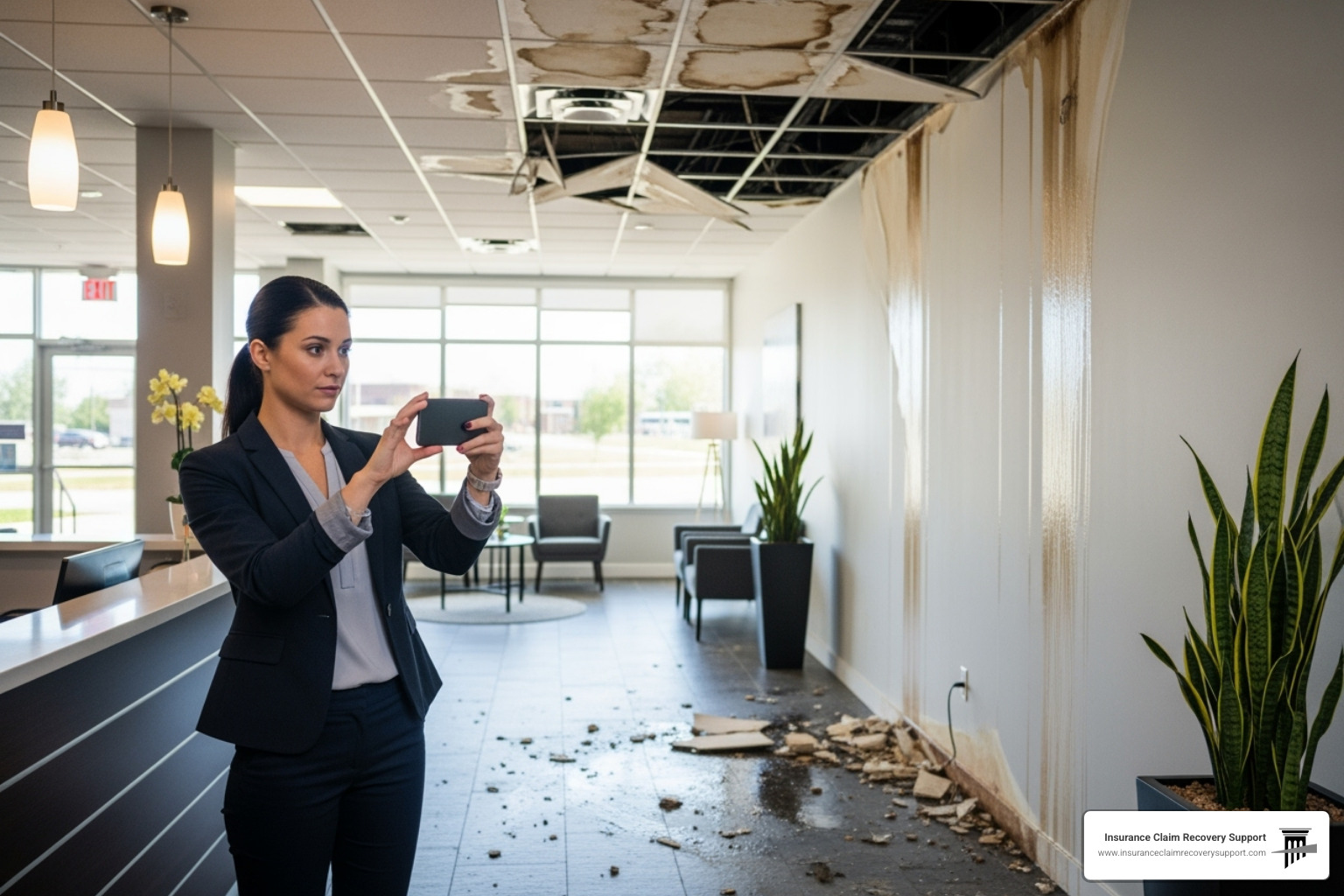
Step 1: Prioritize Safety and Mitigate Further Damage
Safety comes first. Ensure everyone is safe and call emergency services if there’s immediate danger like a gas leak or structural collapse.
Next, you have a “duty to mitigate”—a policy requirement to take reasonable steps to prevent further damage. Neglecting this can jeopardize your claim. Mitigation includes tarping the roof, boarding up windows, and shutting off water mains, gas, or electricity if there’s a safety concern.
Keep all receipts for these emergency costs, which are often reimbursable. These are temporary, not permanent, repairs. Do not begin reconstruction or discard damaged items before the insurer’s assessment. For detailed guidance, see our More info on Tips for Filing Claims.
Step 2: Notify Your Insurer and Document Everything
Once the area is safe, contact your insurance company promptly (usually within 24-72 hours). Have your policy number and loss details ready.
Thorough documentation is non-negotiable. Take extensive photos and videos of all damage, from wide shots to close-ups, before any cleanup. Keep detailed written notes of events and conversations with your insurer.
Create a detailed inventory of damaged items, noting their description, age, cost, and replacement value. Pre-loss photos are invaluable for proving the property’s prior condition. Store all documentation in the cloud for secure access. Our More info on Large Loss Claim Documentation Lists can help you stay organized.
Step 3: Understand Who You’re Dealing With (And Don’t Sign Away Your Rights)
The insurance company will assign a company adjuster who works for them, not you. Their job is to settle the claim for the lowest amount possible under the policy.
Be cooperative but don’t rush decisions. Avoid signing documents you don’t understand, especially an Assignment of Benefits (AOB) from a contractor, which can transfer your claim rights to them.
This is the time to consider hiring a public adjuster, a licensed professional who works exclusively for you. Their role is to advocate for your rights and maximize your settlement. The initial offer you receive is rarely final. Understanding More info on what a Public Insurance Adjuster is could make a significant difference in your recovery.
Navigating the Commercial Property Loss Claim Process
With the immediate emergency over, the strategic journey of your commercial property loss claim begins. A methodical approach is essential for businesses that want to recover fully.
Building Your Case: Crucial Documentation for Your Commercial Property Loss Claim
Your claim documentation must tell the complete story of your loss and its financial impact. Without solid evidence, legitimate claims can be undervalued or denied. Key documents include:
- Proof of Loss form: A sworn statement of your damages and claimed amount. Submit it promptly, usually within 60 days of the insurer’s request.
- Detailed repair estimates: Get multiple quotes from licensed contractors that break down all costs. These can reveal hidden damage.
- Invoices and receipts: Keep every receipt for emergency services, temporary repairs, and mitigation.
- Financial records: For business interruption claims, gather P&L statements, tax returns, and payroll records. A forensic accountant can help calculate the full impact.
- Supporting documents: Collect pre-loss photos, leases, blueprints, and detailed inventory records. Store digital copies of everything in a secure, cloud-based system.
For additional guidance, visit our More info on Large Loss Claims resource.
The Adjuster’s Role: Company Adjuster vs. Your Public Adjuster
Understanding the difference between adjusters is critical.
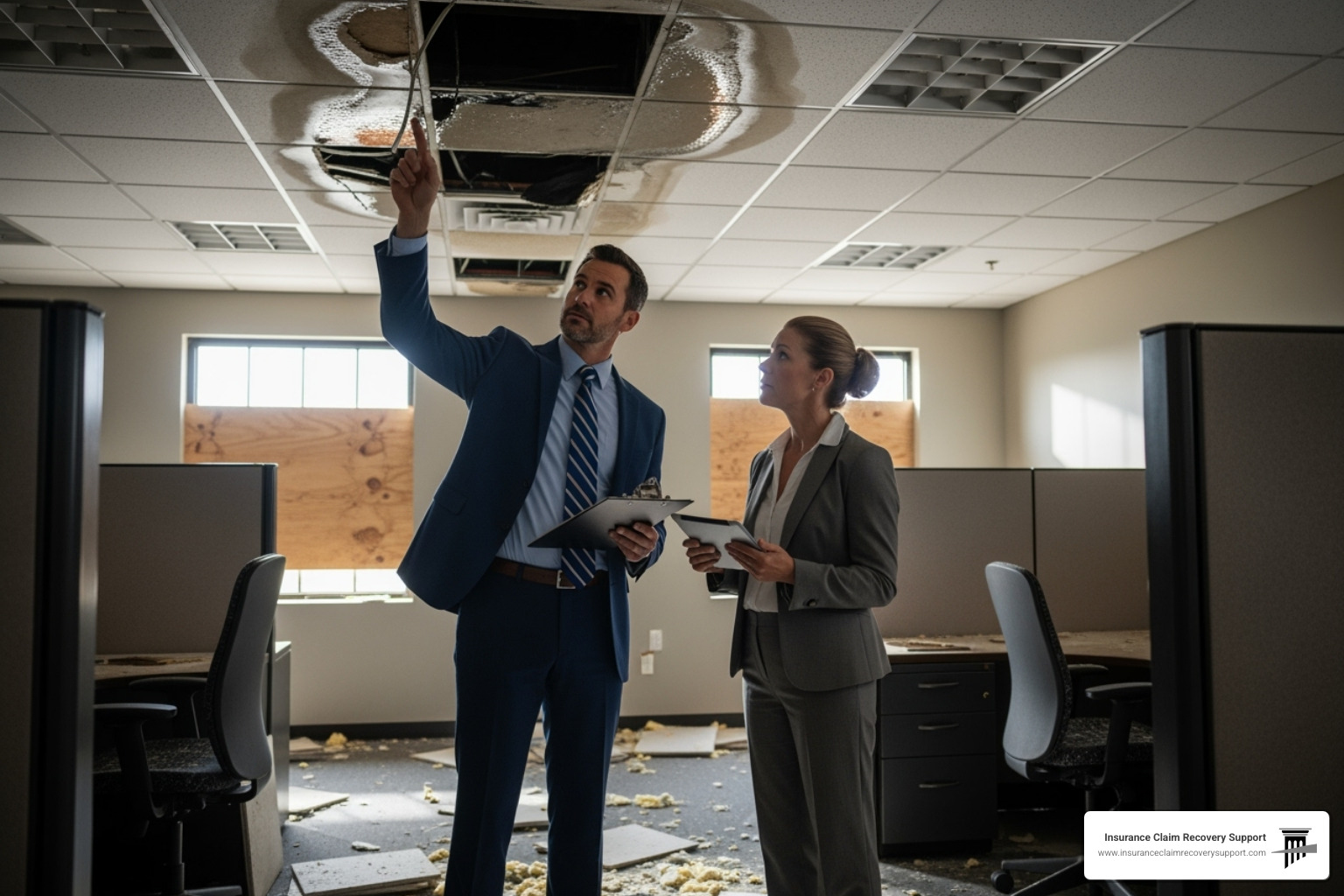
The company adjuster works for the insurer, not you. Their goal is to minimize the payout by undervaluing damages or finding policy violations.
A public adjuster works exclusively for you, the policyholder. We level the playing field by reviewing your policy, documenting all damages (including hidden ones), and preparing comprehensive estimates to ensure you are fully compensated. The difference is simple: the company adjuster represents the insurer’s interests, while your public adjuster represents yours. Learn more at More info on Commercial Property Public Insurance Adjusters.
Negotiating a Fair Settlement and Overcoming Lowball Offers
The insurer’s initial settlement offer is a starting point for negotiation, not the final word. Review it carefully against your own estimates and documentation. Identify any discrepancies, missed items, or undervalued damages.
Providing counter-evidence is your most powerful tool. Present your independent estimates and documentation, especially for hidden damages like smoke penetration or unseen water damage. Independent assessments from engineers or architects can carry substantial weight in disputes.
Patience and persistence are key. A public adjuster can handle these negotiations professionally while you focus on your business. For more strategies, see More info on How to Negotiate with Insurance Adjuster for Property Damage.
Common Reasons for a Denied Commercial Property Loss Claim
Understanding common reasons for denial can help you avoid them or challenge an unfair decision. Claims are often denied for:
- Late reporting: Missing strict policy deadlines.
- Insufficient documentation: Failing to prove the full extent of your loss.
- Excluded perils: Damage from a cause not covered by the policy (e.g., flood without flood insurance).
- Policy violations: Failing to mitigate damage, maintain the property, or providing misleading information.
- Suspected fraud: Intentionally exaggerating or falsifying a claim.
- Failure to cooperate: Not providing requested information or property access.
If your claim is denied, request a detailed explanation and seek a second opinion. We specialize in overturning denied claims. Learn more at More info on Denied Insurance Claim for Fire Damage to Commercial Property.
Beyond the Claim: Proactive Preparedness and Post-Settlement Recovery
Your commercial property loss claim journey isn’t over when the settlement check arrives. Smart business owners know that pre-disaster preparation and post-settlement management are just as crucial as the claim itself.
Before Disaster Strikes: A Business Owner’s Preparedness Checklist
The businesses that recover fastest are those that prepare before a disaster strikes.

- Annual policy reviews: Ensure your coverage keeps pace with your business’s changing value and risks.
- Comprehensive property inventory: Keep a detailed, updated record of all equipment, furniture, and inventory with photos or videos.
- Cloud-based document storage: Securely store copies of policies, inventories, and financial records off-site.
- Disaster plan: Create clear procedures and assign roles for emergencies.
- Key contacts list: Keep an accessible list of your insurer, public adjuster, and emergency services.
- Secure important files: Back up all critical business and customer data off-site.
Smart preparation minimizes frustration. For more strategies, check out More info on 7 Ways Commercial Building Owners Maximize Insurance Claims.
After the Settlement: The Path to Restoration and Rebuilding
The restoration phase after settlement requires careful management.
- Choose the right contractors: Vet licensed, reputable professionals and get multiple bids.
- Manage the repair process: Stay involved to ensure work quality and timelines are met.
- Document recovery expenses: Continue tracking all costs related to the restoration.
- Understand recoverable depreciation: Submit final documentation to receive the remaining depreciation value held back by the insurer.
- Final payment processing: Ensure all funds are received once repairs are complete.
- Review coverage post-claim: Reassess your insurance needs based on the experience.
Special Considerations for Claims in Texas
Texas faces unique weather challenges that impact a commercial property loss claim.
- Hurricane damage is a major risk for coastal cities like Houston, requiring separate flood insurance and an understanding of percentage-based windstorm deductibles.
- Tornado activity threatens Central and North Texas cities like Dallas, Fort Worth, and Austin, making comprehensive coverage essential.
- Freeze damage can cause burst pipes and flooding across the state, from San Antonio to Lubbock.
- Fire damage remains a constant threat from accidents or wildfires.
Texas has specific prompt payment laws, but disputes still arise. Local building codes in cities like Austin, Dallas, and Houston also impact rebuilding costs. An expert familiar with the Texas insurance landscape is vital. For more information, visit More info on Storm Damage Insurance Claim.
Conclusion
Facing a commercial property loss claim is challenging, but with the right approach, it’s a manageable process. This guide provides a roadmap, from understanding your policy to navigating the first 48 hours.
Success is built on preparation and documentation. Understand your policy, create a detailed property inventory, and when a loss occurs, document everything with photos, videos, and notes. This evidence is crucial for proving your claim.
The insurer’s adjuster works for them, not you. Their goal is to protect their employer’s bottom line, which makes professional advocacy on your behalf essential.
Complex claims require expertise. At Insurance Claim Recovery Support, we provide that expertise, working exclusively for you. Our advocacy can transform outcomes, overturning denials and securing fair settlements that are often significantly higher than initial offers.
Whether your business is in Austin, Houston, or Dallas, the principles are the same: stay calm, document everything, know your rights, and seek expert help. The insurance company has a team of experts; you should too. We work to maximize your recovery and protect your investment.
If you’re facing a commercial property loss, take a deep breath. You’ve got this – and if you need help, we’ve got you.

